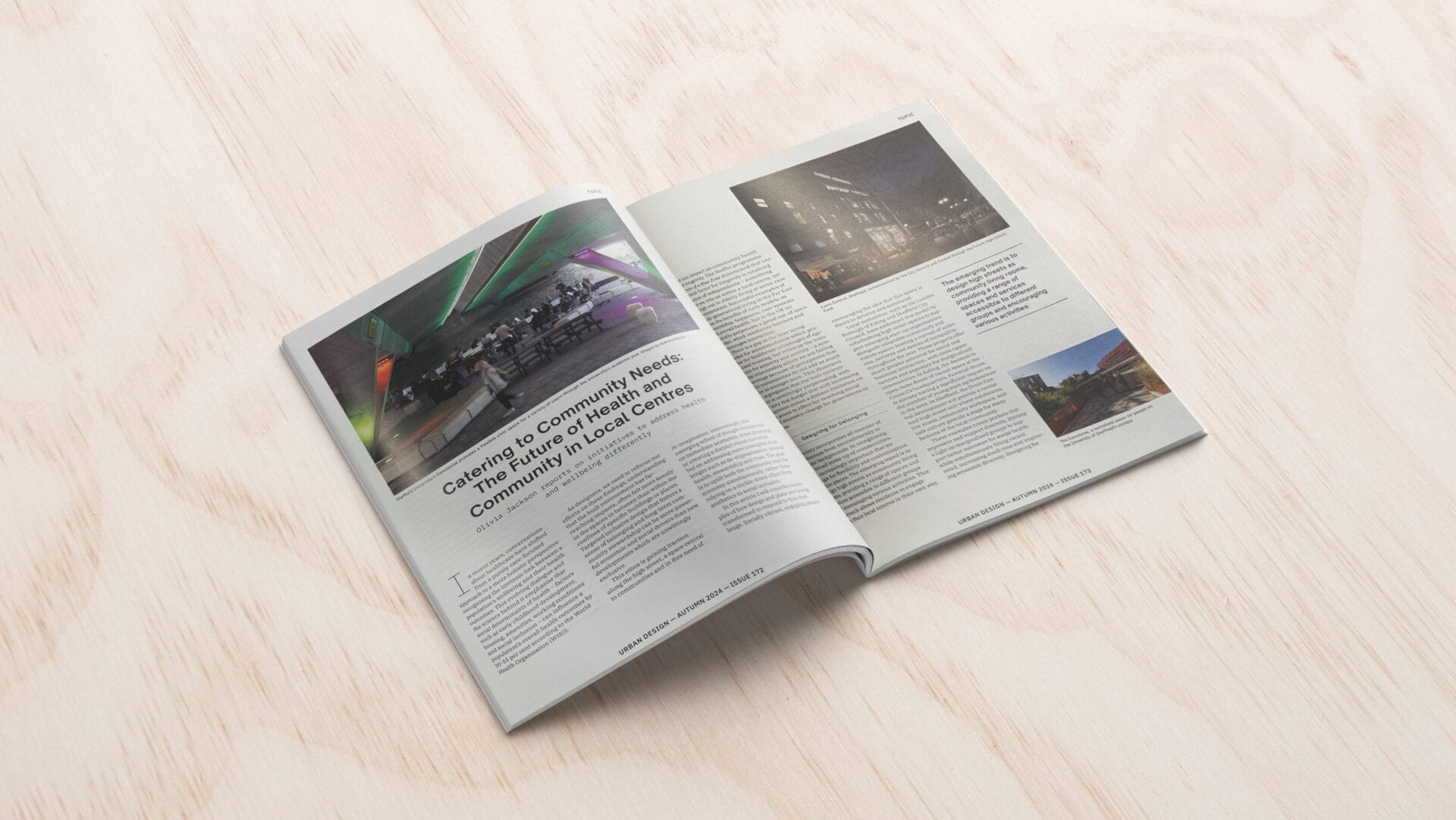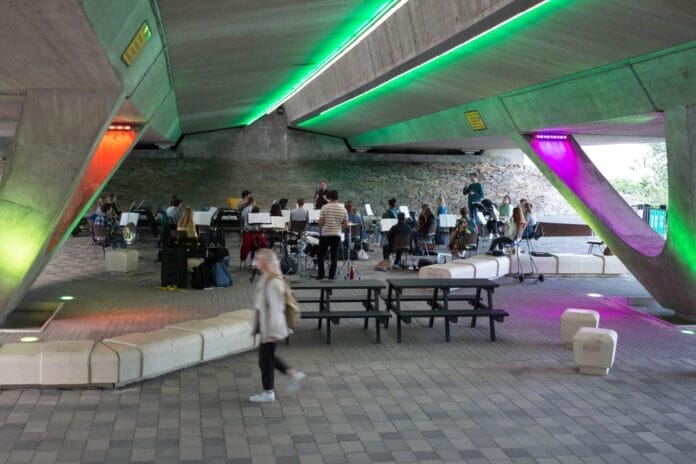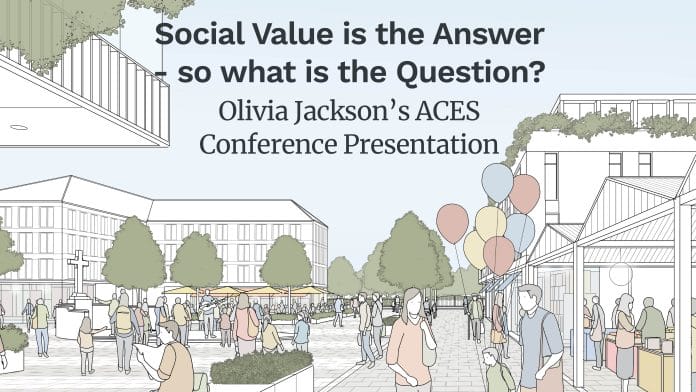
Head of Regeneration, Olivia Jackson reports for the Autumn edition of the Urban Design Journal on initiatives to address health and wellbeing differently:
In recent years, healthcare conversations have shifted from a purely care-focused approach to a more holistic perspective that recognizes the intrinsic link between a population’s wellbeing and their health outcomes. This evolving dialogue and the science behind it now emphasize that social determinants of health—factors such as early childhood development, housing, amenities, working conditions, and social inclusion—can influence a population’s overall health outcomes by 30-55% (WHO, 2024).
The emerging trend is to design high streets as community living rooms, providing a range of spaces and services accessible to different groups and encouraging various activities.
As designers, we need to refocus our efforts to target these findings, understanding that the built environment has far-reaching impacts, often felt more keenly in the ‘spaces in between’ than within the confines of specific buildings or places. Targeted, inclusive design that fosters a sense of belonging and long-term community stewardship can be more powerful economic and social drivers than new developments which are unwittingly exclusive.
This ethos is gaining traction along the high street, a space central to our communities and in dire need of re-imagination. Interestingly, this emerging school of thought focuses not on immediate aesthetics, mass greening, or creating a distinct visual narrative, but on addressing more intangible challenges such as destigmatization, mental health, stewardship, and trust. The goal is to uplift both the community and the economy simultaneously, rather than relying on a trickle-down effect from aesthetics to social inclusion.
In this article, I will consider examples of how design and place are transforming to respond to this challenge. I will explore how socially vibrant, engaging places that focus on the social determinants of health can greatly benefit both community and place, creating space for long-term community stewardship that will future-proof our local centres and positively impact the overall health outcomes of our communities.

De-stigmatising Health
One significant challenge in the UK, highlighted during the COVID-19 pandemic, is the stigma attached to accessing health services, often seen as an admission that something is wrong rather than a step in the right direction. This stigma reduces the number of people who seek advice early, significantly impacting both individual health and the pressure on the NHS. Design and collaboration can play a crucial role in destigmatizing and de-sterilizing community healthcare by integrating it into daily life rather than isolating it as a perceived ‘naughty step.’
An example is HLM’s project in Staines, a collaboration with Bell Phillips Architects and the North West Surrey Alliance. This project combines residential, amenity, café, and health services situated on the main route between the station and the high street. The communal entrance zone integrates health services into daily life, detaching them from their traditional sterile environments and allowing health to be perceived as an extension of the high street and residential communities. This represents an emerging recognition that community and health offerings are stronger together and both have a valuable place on our local high streets. The NHS encourages this principle as a way to focus more on preventative care than reactive medicine and as such this trend is growing from simple integration to true co-location.
Projects in Tandridge exploring the integration of library services, council workspace, and healthcare offerings, as well as department store and shopping centre conversions across the country merging diagnostic centres, F&B, local businesses, and national retail brands, illustrate this trend. Health as a de-stigmatized factor of daily life helps remove barriers that directly impact access to care and encourages a society of prevention over reaction.
‘Mental health on the high street’ is an emerging trend manifesting in projects such as the Kadampa meditation café in Glasgow (picture above).
Addressing Mental Health
However, addressing physical healthcare is only part of the solution. The Joseph Rowntree Foundation describes Britain’s mental health crisis as an ‘epidemic,’ with emerging medical studies increasingly linking poor health to factors such as loneliness, anxiety, and stress. While there are many contributing factors to poor mental health, our built environment has a huge impact not only on how we feel but on how we interact with each other.
‘Mental health on the high street’ is an emerging trend manifesting in projects such as the Kadampa meditation café in Glasgow (figure 1). Designed by HLM’s interiors team, this project aims to integrate aspects of wellness with traditional high street offerings such as café and workspace, using design features and materials to reinforce a calm environment that offers an open, accessible frontage with the option of respite from the city’s bustle. This project helped revitalize a vacant retail unit on Hutcheson Street, demonstrating that accepting and embracing a spectrum of needs can provide much-needed innovation that revitalizes both people and place.
Designing to improve mental health, however, is about more than presence on our high streets. Fundamentally, it is a sense of belonging and accessibility that our spaces need to foster, reducing barriers between our communities and the spaces they inhabit.
“There’s a real danger that increasing separation comes with a distinct limitation on our power to effect far-reaching social and economic change that will last for generations to come.”
Segregated Communities
Despite positive trends, we are still actively designing out many communities. For instance, many local centre initiatives primarily target a younger demographic, creating barriers that can impact community health and longevity. The Netflix programme ‘Secrets of a Blue Zone’ determined that one critical factor for longevity is retaining a sense of independence—something that we rely on within a local centre yet design out in ‘later living’ or ‘extra-care’ developments. Successful examples of multi-generational living in the Far East show the benefits of such models on stewardship, happiness, care systems, and overall health, but in the UK, we typically perpetuate a ‘gated, out-of-town’ model which reinforces barriers and discourages interaction.
There is a gap in the ‘later living’ market for accommodation which provides the healthcare advantages of age-focused housing but relies on the town centre for amenity and activity—a symbiotic relationship which we are failing to leverage because of the perception that an older community does not add as much value as a younger demographic.
Whilst only one example, this adequately illustrates the segregation our built environment is unwittingly ‘building,’ with the very real danger that increasing separation comes with a distinct limitation on our power to effect far-reaching social and economic change that will last for generations to come.

‘Diversity’ incorporates all manner of differences—from neurodiversity to ethnic backgrounds—and in recognizing the broad makeup of our communities, it is increasingly important that we design for flexibility and customization within our places.
Designing for Belonging
The emerging trend is to consider designing our high streets as community ‘living rooms,’ providing a range of spaces and services accessible to different groups and encouraging various activities. This approach allows residents to engage with their local centres in their own way, encouraging the idea that this space is theirs to develop and command. Local authorities, such as the London Borough of Ealing and Sheffield City Council, have embraced this model by refurbishing high street spaces to support emerging start-up organisations alongside adaptable community and events spaces hosting a myriad of activities, services, and spaces of tranquility throughout the year.
These projects offer much greater potential for social and business interaction, with more opportunities and exposure for marginalized communities. In Ealing’s case, their decision to open up three floors of vacant space at their HQ—Percival House—is already significantly impacting the number of young start-up businesses in the area whilst in Sheffield, the ‘Events Central’ development (Figure 2) will provide a revitalized high street unit where exhibitions, live music, community workspace, and café culture provide a ‘stage’ to many factions of the local community.
These examples create pockets that represent and support diversity, shining a light on marginalized groups to support better outcomes for social health while simultaneously filling vacant retail, increasing dwell time, and improving economic diversity. Designing for ‘health,’ therefore, is about so much more than clinical spaces or environmental factors—it is about putting local centres at the centre of a culture of ‘belonging’ by fostering a community who believe they have the power and potential to effect the change they want to see.

Trust in Design
Fundamentally, there is a commonality (and a deficiency) of trust. Whether encouraging residents to trust in the services provided, trusting that giving communities free rein within their local centres will have a positive long-term impact, or trusting that members of ostracized groups will add value if allowed the chance, we have been guilty of designing spaces which either actively or passively imply a lack of trust. From fences to signs to entrance barriers, we are encouraged to provide for the worst-case scenario and in doing so send out an expectation that often becomes a self-fulfilling prophecy.
However, examples such as the revitalization of the Sheffield Concourse for the University of Sheffield (Figure 3 & 4) or Waltham Forest’s new landscaping and entrance area for their town hall show that designing spaces and places that are open, free from barriers, activated at night, and allow everyone in can have an immensely positive impact on the key markers of both community and economic success.
Behaviour, footfall, dwell time, socialization, and security are just a few factors positively impacted by designing with trust—all of which have a clear relationship to the social determinants of health. Addressing ‘trust’ rather than ‘security’ as an industry standard is the final piece of the puzzle in designing truly inclusive, healthy communities, and it is up to us to make it happen.
By addressing the social determinants of health through inclusive and thoughtful design, we can create spaces where people truly belong, supporting their health, the community’s wellbeing, and the success of our local centres as one integrated solution.
In a Nutshell
Delivering this type of design is not without its challenges, and my final conclusions set out a few essential bridges to cross in any regeneration project looking to deliver a truly ‘healthy’ local centre:
- It is essential to develop a clear ‘on the ground’ understanding of the services that are truly required in each community so that ‘real people’ can be engaged from day one.
- Partnerships often begin through two or more organizations that have little to nothing in common. This enables each party to bring something different to the table but will also cause friction that will need to be worked through. This will take time (and heartache) but will be worth it.
- There is a requirement to ‘invest to save’—creating spaces may have an upfront capital cost, but the long-term benefits in service delivery efficiency and/or preventing acute care later more than justify the cost.
- Given the above, the approach to funding and viability models needs to be more innovative – taking a long-term view to truly realise value.
- Trust doesn’t happen overnight, but the mindset of ‘questioning barriers’ rather than reinforcing them can have a huge impact on community wellbeing and civic relationships.
Ultimately, designing for health and community is one of the next clear trends for our local centres—creating a vibrancy and diversity that not only revitalizes and supports a local economy but reverberates much further into the long-term lives and health of our communities. To do so, we need to shift our mindset away from the obvious aspects of the built environment—buildings and public realm—and challenge ourselves to design for the ‘spaces in between.’ These elements—thresholds, movement, independence, stigma, trust, and more—significantly impact a sense of belonging, which is not only a key aspect of health but essential for the long-term community stewardship that our centres need if they are to survive. By addressing the social determinants of health through inclusive and thoughtful design, we can create spaces where people truly belong, supporting their health, the community’s wellbeing, and the success of our local centres as one integrated solution.
Related posts



